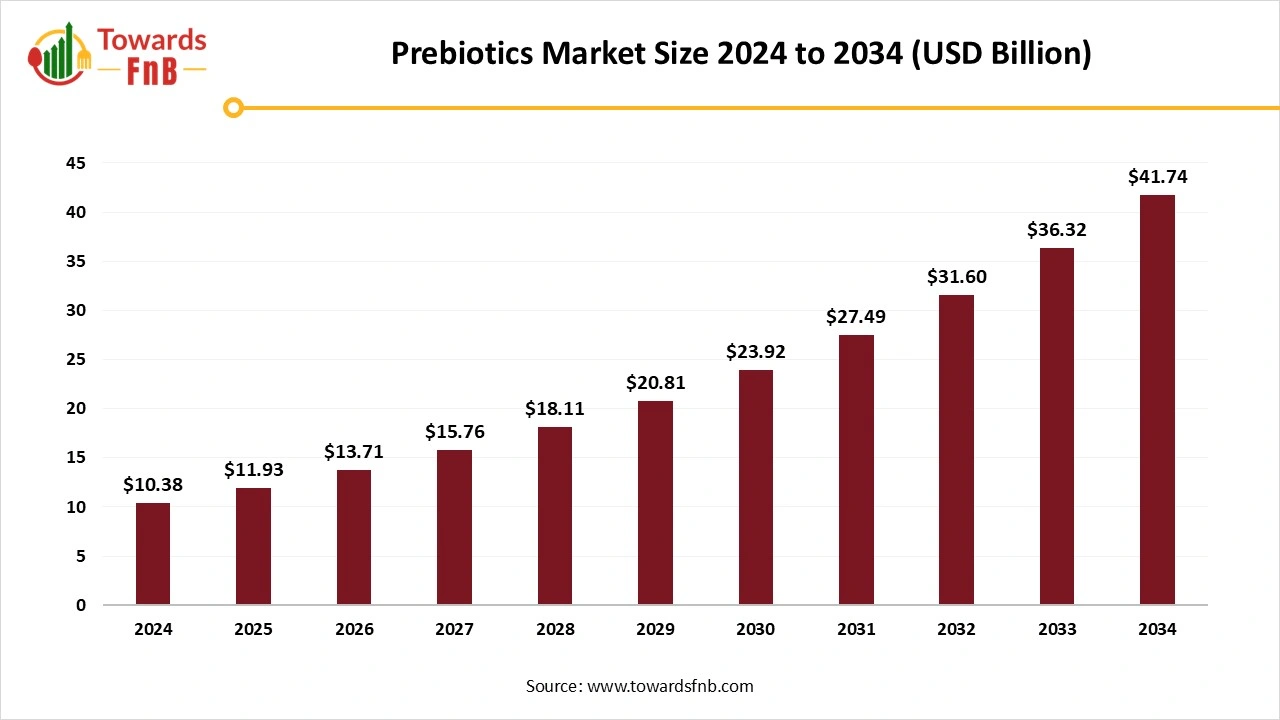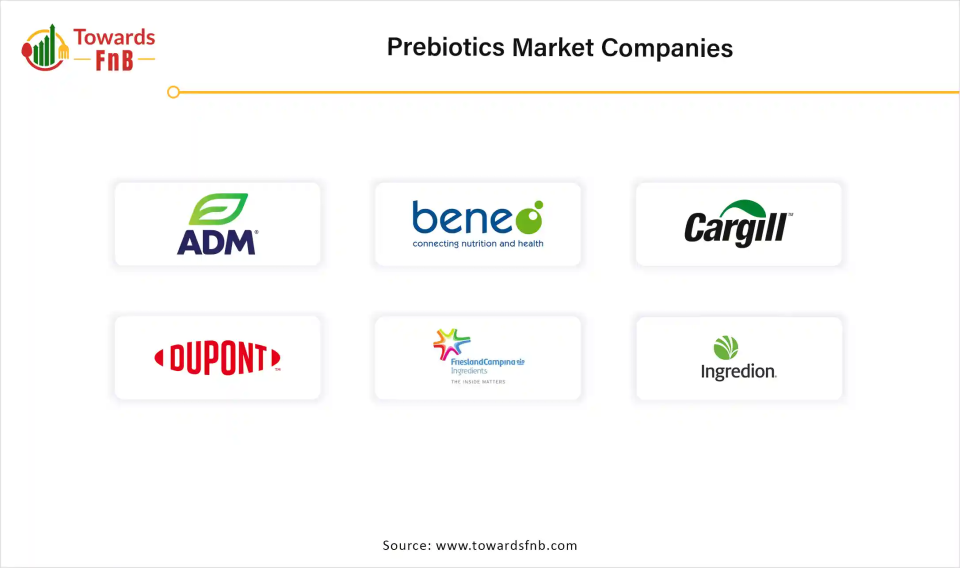December 2025
The global prebiotics market size reached at USD 10.38 billion in 2024 and is anticipated to increase from USD 11.93 billion in 2025 to an estimated USD 41.74 billion by 2034, witnessing a CAGR of 14.93% during the forecast period from 2025 to 2034. The increased preference for personalized biotics, whole foods, and functional foods has raised the importance of prebiotic components.

| Study Coverage | Details |
| Growth Rate from 2025 to 2034 | CAGR of 14.93% |
| Market Size in 2025 | USD 11.93 Billion |
| Market Size in 2026 | USD 13.71 Billion |
| Market Size by 2034 | USD 41.74 Billion |
| Largest Market | North America |
| Base Year | 2024 |
| Forecast Period | 2025 to 2034 |
| Regions Covered | North America, Europe, Asia-Pacific, Latin America, and Middle East & Africa |
The prebiotics market revolves around prebiotics that can be administered orally or directly. The positive effects of prebiotics include cardiometabolism, mental health, hyperlipidemia, antioxidants activity, brain and bone health, etc. The promising therapeutic approaches are prebiotics, postbiotics, and probiotics that influence positive health outcomes.
Recent advances in prebiotics include the development of synbiotics, which is the combination of prebiotics and probiotics designed to enhance gut health. There is great progress in analytical technologies and techniques such as metagenomics, high-throughput screening, and metabolomics.
The various regions and countries vary in regulations and face supply chain issues. The crucial parameters like standardization and consistent quality control are needed to resolve these issues. These factors help to maintain market stability and gain consumer trust in the supply chain in the case of food and beverage ingredient sourcing.
How North America Dominated the Prebiotics Market in 2024?
North America dominated the prebiotics market in 2024 owing to research and funding initiatives for biomedical research including prebiotics. The National Institute of Health (NIH) focuses on major research topics related to gut health and microbiome and prioritizes human-oriented research. Research also focuses on dietary fiber intake, food loss and waste reduction, diet, and gut health. In February 2025, the U.S. FDA announced the finalization of an updated ‘Healthy’ nutrient content claim. In June 2024, the USDA and Reinvestment Fund announced the launch of a new program to increase access to healthy foods in underserved communities.
How does the U.S. Expand Research and Development Capabilities Across Food Systems?
In October 2024, the U.S. Department of Health and Human Services (HHS) announced the funding of the Pro/Prebiotic Regulation for one of the projects named the Optimized Treatment and Eradication of Clinical Threats (PROTECT). This project aims to promote the use of beneficial bacteria to fight against harmful bacteria. The U.S. Food and Drug Administration (FDA) works on dietary supplements in coordination with the Human Foods Program’s Office of Food Chemical Safety, Dietary Supplements, and Innovation. The FDA regulates dietary supplements under different regulations. FDA also provides regulations and guidance related to prebiotics as dietary supplements and food ingredients. The U.S. Department of Agriculture (USDA) and Agricultural Research Service (ARS) planned to conduct research projects related to prebiotics and functional food.
Asia Pacific is expected to grow at the fastest growth in the prebiotics market during the forecast period
Due to the major efforts towards innovative technologies to fight against hunger and malnutrition. In September 2024, the Food and Agriculture Organization of the United Nations reported that the Asian Pacific countries participated in one of the major initiatives to explore advanced technologies. This event focused on integrating nutrition into agricultural production as an important parameter. It also paid attention to creating healthy food options and providing benefits to farmers and consumers.
How is India Progressing through Supportive Measures?
India aims to accelerate high-performance biomanufacturing by boosting technological development and commercialization. India also makes efforts to establish biomanufacturing hubs and biofoundries. The BioE3 policy of India was approved by the Union Cabinet, which stands for biotechnology and focuses on the economy, employment, and the environment.
How Fructooligosaccharides (FOS) Segment Dominated the Prebiotics Market in 2024?
The fructooligosaccharides (FOS) segment dominated the market in 2024 owing to the research-backed health benefits of FOS. These benefits include the prebiotic nature of FOS, a great source of fiber, and improved mineral absorption. The FOS products help to deal with harmful bacteria, reduce blood sugar levels, and reduce cholesterol. The natural sources of fructooligosaccharides are garlic, chicory root, bananas, asparagus, onion, and other food sources that provide good amounts of prebiotic fiber. The fructooligosaccharides are also considered as alternative sweeteners containing more fiber and fewer calories.
The xylooligosaccharides (XOS) segment is expected to grow at the fastest CAGR in the market during the forecast period, due to the health benefits of xylooligosaccharides in digestive health, immune support, and cardiometabolic support. The dietary supplementation of XOS helps in weight management, improved growth performance, and lipid metabolism in cases of type 2 diabetes mellitus conditions and in normal people.
What made Food & Beverages – Dairy Products the Dominant Segment in the Prebiotics Market in 2024?
The food & beverages segment dominated the prebiotics market in 2024 owing to the increased preferences of people for the consumption of fruit juice, yogurt drink, healthy snacks, and healthy bakery products in the morning due to the best time to consume food and beverages. The increased risk of obesity and other diseases has raised the need for nutritious food and beverage formulations with optimal taste. The empowered consumers and science-backed research take regulatory action to fight health concerns. The adoption of a proactive approach to health and wellness by consumers in the Middle East, North Africa, and Turkey created the growth of food and beverages due to their health benefits.
The dairy products segment held the largest share as a sub-segment due to the nutritious benefits of dairy products. The consumers preferring milk and dairy products are experiencing healthy muscles, teeth, eyes, bones, nerves, skin, and vision. These products help to reduce tiredness and fatigue by releasing energy from foods and maintaining healthy blood pressure. They support normal growth, brain development, and normal immune functioning.
The dietary supplements segment is expected to grow at the fastest CAGR in the market during the predicted timeframe, due to the provided nutrients from these supplements that can be taken in the form of capsules, tablets, powders, and energy drinks. The availability and improved access to the common supplements such as vitamins, minerals, calcium, iron, and herbal supplements has raised the importance of health and wellness.
How did the Powder Segment Dominate the Prebiotics Market in 2024?
The powder segment dominated the prebiotics market in 2024 owing to the pivotal role of powdered forms of prebiotics in improving gut health, digestion, mineral absorption, and immune system. They help consumers with better bowel function and strengthen their immune response. They reduce inflammation and risk of certain diseases, manage weight, and improve blood sugar control. Prebiotics in the form of powders result in improved metabolic health and increased bone density.
The liquid segment is expected to grow at the fastest CAGR in the prebiotics market during the forecast period due, to a major role of liquid prebiotics in managing cholesterol, satiety, and weight, reducing the risk of chronic diseases, and promoting the digestive system health of consumers. They can improve the anti-inflammatory response of the human body and contain high amounts of fermentable soluble fiber.
How Natural Segment Dominated the Prebiotics Market in 2024?
The natural segment dominated the prebiotics market in 2024 owing to the natural presence of prebiotics in various plant-based food such as chicory root, onion, garlic, bananas, whole grains, and other foods. These natural sources of prebiotics result in improved mental health and mood, enhanced immune function, improved digestive health, regulation of blood sugar levels, bone health, and weight management. The incorporation of prebiotic-rich foods into diets nourishes the gut microbiota and offers numerous health benefits. Naturally sourced prebiotics hold the power of longevity and optimal health. They support and nurture the growth of healthy bacteria in the gut while offering various health benefits to humans.
The Synthetic Segment is Expected to Grow at the Fastest CAGR in the Market During the Predicted Timeframe
Due to the potential role of different synthetic prebiotics such as fructooligosaccharides (FOS), lactulose, and galacto-oligosaccharides (GOS). They are considered safe and have long-term effects on certain medical conditions. They can better manage weight and glucose metabolism while potentially influencing mental health.
What Made Food and Beverage Manufacturers the Dominant Segment in the Prebiotics Market in 2024?
The food and beverage manufacturers segment dominated the market in 2024 owing to industrial efforts to produce a wide range of products by replacing sugar and fat and improving the mouthfeel of potential consumers. The food and beverage industrial manufacturers focus on improving the sensory, textural, and physiological benefits of these products. The produced prebiotics have various applications across the food industry; beverage, dairy, processed fruit, vegetable, bakery, confectionery, sweetener, infant formula, pet food, and livestock industries. The manufacturers aim to achieve clear labeling, transparency, product compatibility, effective dosage, formulation, and processing. They also adhere to regulatory compliance and quality assurance standards.
The Dietary Supplement Manufacturers Segment is Expected to Grow at the Fastest CAGR in the Prebiotics Market During the Forecast Period.
Due to compliance with regulations and standards. The adoption of good manufacturing practices and achieving certifications introduces enhanced transparency and accountability across research and manufacturing sectors. It becomes possible to assess quality and safety measures through certifications from reputed organizations like ISO, NSF International, and United States Pharmacopeia (USP).
ADM
Ingredion Incorporated

By Product Type
By Application
By Form
By Source
By End Use
By Region
December 2025
December 2025
December 2025
December 2025